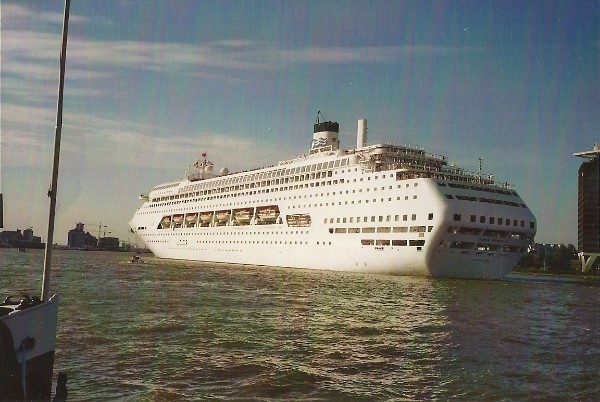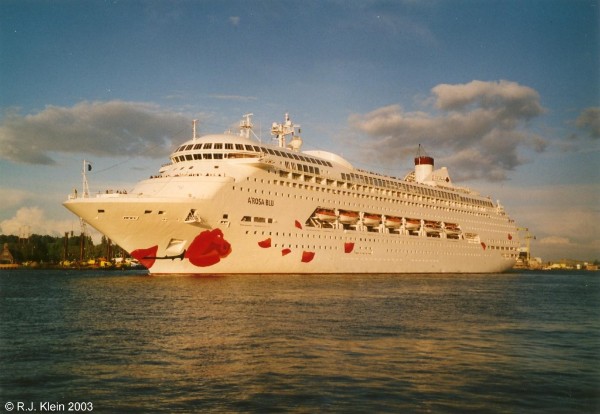Crown Princess (I)

Crown Princess leaving Amsterdam at the 24th of may 2001. Sadly, the picture is not up to my normal standards.
Today, we take for granted that a lot of modern cruiseliners are built at the several Fincantieri wharfes in Italy. But this wasn't always so. When in 1966, the Eugenio C. was delivered to Costa Lines, she was the last passengership to be built in Italy untill 1984, when Sitmar Cruises approached Fincantieri for the building of a new superliner. Sitmar also had contacts with another shipbuilding firm, Chantiers de L'atlantique at Saint Nazaire, France, who had delivered some very fine passengerliners in the past. Eventually, the contract for the first of the planned three newbuilds for Sitmar, that would bring them up to the front of the cruise-industry, was awarded to the French company because they could give better warranties. But non the less the deal with Fincantieri also went ahead, and they were chosen to built the next two ships for the line as the first cruiseships built in Italy for over two decades. Sitmar, as an Italian-based company, were very excited about this, and of course also Fincantieri was very happy with the order.
When the French-built ship was delivered in 1986, named Sitmar Fairmajesty, talks with Fincantieri were also very well underway. On the 19th of december 1984, Sitmar presented the general arrangement plans to Fincantieri, a ship based on the lay-out of the succesfull Fairsky, that had just been delivered as the companies first newbuilt ever. To give the ships a very Italian look, the world-famous architect Renzo Piano was chosen for the overall design of the ship as well as the design of the interiour spaces of the three top decks. Originally, the ship was to be driven by steamturbines, that had proven so reliable in the past, but it was later decided, also because of the succesfull rebuilding of the Queen Elizabeth 2 that the ship would be built with diesel-electric propulsion. Fairsky would thus be the very last passengership to be built with steamturbines, because also the French-built Sitmar Fairmajesty was later in the design-process changed from steamturbine to diesel-electric propulsion. In the new Italian built ship, that was to have one sistership too, one of the requests by Sitmar as to give the ship many outside cabins, at least 85%. Normally, ships of that time were having around 65% outside cabins. The owner of Sitmar, the well-known Boris Vlasov, was largely involved in the total design of the ship, but sadly, he died on the 2nd of november 1987. But the ship still was a true brainchild of Vlasov.
Renzo Piano designed the upper decks as a voluminous piece, yet refined. With the design of a large dome over the bridge area, in which he reproduced the head of a swimming dolphin (the bridgewings being the eyes), he truly changed the classic cruiseship into the modern day megaliner. He actually started this idea of designing a modern cruiseship when he was asked to do so by Romano Prodi, the later Italian Prime-Minister, when Prodi was working as President of IRI, the owners of Fincantieri before the Sitmar ship was laid down and those ideas were presented in Los Angeles in March 1988.
As A'rosa Blu, the ship is shown leaving Amsterdam at the 13th of may 2003. In this picture, you canclearly see the design as a swimming dolphin if you use your architectural imagination well...

The ship was laid down at the Monfalcone shipyard of Fincantieri at the 7th of june 1988 as yardnumber 5839. One month after this, because of the death of Boris Vlasov, the company was sold to P&O. This was done because Vlasov had set up a guarantee trust for his family, that when he died the company would be sold providing them with some fiancial security. This sale only implemented Sitmar, the rest of the Vlasov Group today survives as V-ships, a company providing the management for ships within Silversea Cruises, Regent Seven Seas Cruises and many others. The ship was named Crown Princess when P&O placed her within the ever growing fleet of Princess Cruises, that also recieved the Sitmar Fairmajesty as Star Princess and the sistership of the Crown Princess, the soon to be Regal Princess. With these three ships, Princess more then doubled its capacity in one year and it laid the foundations of the company we know today. Crown Princess floated out of her buidling dock at the 25th of may 1989 and was delivered to her owners in Triest at the 29th of june 1990. She was a splendid ship, the largest cruiseship ever built at 69.845 tons (when not counting the former ocanliners, that is). She has a lenght of 245,08 meters, is 32,28 meters wide and has a draft of 8,10 meters. She had accomodations for a maximum of 2014 passengers, on lower berths this was 1664. Also, 678 crewmembers were aboard on her 11 decks available to passengers. She was registered at Liberia, her homeport being Monrovia. Her first cruise for Princess started at the 8th of july 1990 and took her from Piraeus in Greece into the eastern Mediterranean. During july and august, she kept sailing the Mediterranean, before sailing to New York where she was officially named by Sophia Loren. After several publicity events for the new ship, she sailed south for her first Caribbean season and after that, she was seen on worldwide cruises. On the 26th of june of 2001, the ship's engines broke down completely on a European cruise and she had to be towed into the port of Copenhagen, Denmark. Very shortly afterwards, just three days later, it was announced that she would be leaving the Princess fleet, being replaced into the German market for Seetours. For this, she was to join the Aida as Tosca. Seetours was the former East German company Deutsche Seereederei and it seemed that they were planning to name their ships after well-known opera's. The opera Tosca was written in 1887 by Giacomo Puccini, the opera Aida was of course from Guiseppe Verdi, written in 1871. But this change did not happen, as P&O changed their plans for the Seetours company, it emerged somewhat later as Aida Cruises. Instead, Crown Princess was replaced in the fleet of A'rosa Cruises, a company also within the P&O Group that had formerly sailed with several river cruiseships. With the Crown Princess, that was renamed A'rosa Blu for them, they entered deep-sea cruising. It was also thought that the Regal Princess, the sistership of Crown Princess was to join her within the fleet of A'rosa, but when Carnival took over the P&O Princess group of companies, all was changed. Carnival ended the deep-sea adventures of A'rosa and it was reduced again to a company sailing river cruises in Europe when it was sold to the German company Waterland Private Equity. A'rosa Blu joined the fleet of Aida Cruises, that was the first plan after all, as AidaBlu (I). The ship was mainly used as a trainingpossibility for the crew of Aida Cruises, so they could learn how to work big ships, as Aida was planning to built the six-ship Sphinx-class of around the same size of AidaBlu. One later ship in this class would also recieve the name AidaBlu because the former Crown Princess was only in the fleet for a few years. She was transferred to another company that was within the P&O Princess group, Ocean Village. This company was set up as a clubship operation, a little bit like Aida Cruises, but it was sailing Mediterranean cruises. In november of 2006, the first AidaBlu joined the Ocean Village fleet as Ocean Village 2. As you can see it the name, there was another ship operating for this brand, the Ocean Village and this ship was the former Sitmar Fairmajesty. It seemed a very prosperous new innitiative, so it came a little as a surprise when Carnival announced that the Ocean Village brand was to be discontinued after the summerseason of 2010 and the ships would be transferred to P&O Australia. Ocean Village 2 already left the fleet in 2009, and was refitted for the Australian market, a well-known haven for both Sitmar Cruises, the company that had built and designed her, and P&O Cruises, that had sailed to and from Australia since the middle of the 19th century onwards. In fact, P&O Cruises Australia originated from Sitmar itself. When P&O purchased the company in 1988, they took over the fleet, of which one ship was based year round in Australia as Fairstar. She was the 1957-built troopship Oxfordshire, originally sailing for the Bibby Line. While P&O had renamed and replaced the rest of the Sitmar fleet to Princess Cruises, the name and livery of Fairstar was retained untill that ship was sold for breaking in 1997 and replaced by the Fair Princess, that had been built for Sitmar as their Fairsky.
Over the years, the new owner of P&O Princess Cruises, Carnival, used the Australian fleet for the replacement of old tonnage from the main company. Ocean Village 2 was renamed Pacific Jewel, and within the fleet of P&O Australia, she met the Pacific Dawn, her sistership that had been built as Regal Princess and was in the Australian fleet since 2007. Also the Ocean Village joined the Australian fleet in 2010 as Pacific Pearl, bringing the three Sitmar-designed ships together once more. I know that in Australia not everybody is too happy with the fleet of the company, that only consists out of older tonnage. Down under, they feel they are not worth new ships and a lot of customers seem to flock to other compannies then P&O Australia, who do sail with newer ships that offer more. Understanding their thoughts, it also has some charm, the three ships that were intended to be flagships from Sitmar together in Australian waters at last.
On the 12th of march in 2019, the ship completed her last P&O cruise as she had been sold to the Indian company Zen Cruises. For them, the first true Indian cruisecompany was started up under the name of Jalesh Cruises. Pacific Jewel was renamed Karnika for the new startup and send to the Sembcorp Marine Admirality yard at Singapore for her conversion. In a gala event at Mumbai at the 19th of april 2019, she will be officially introduced as Indias first domestic cruiseliner.

